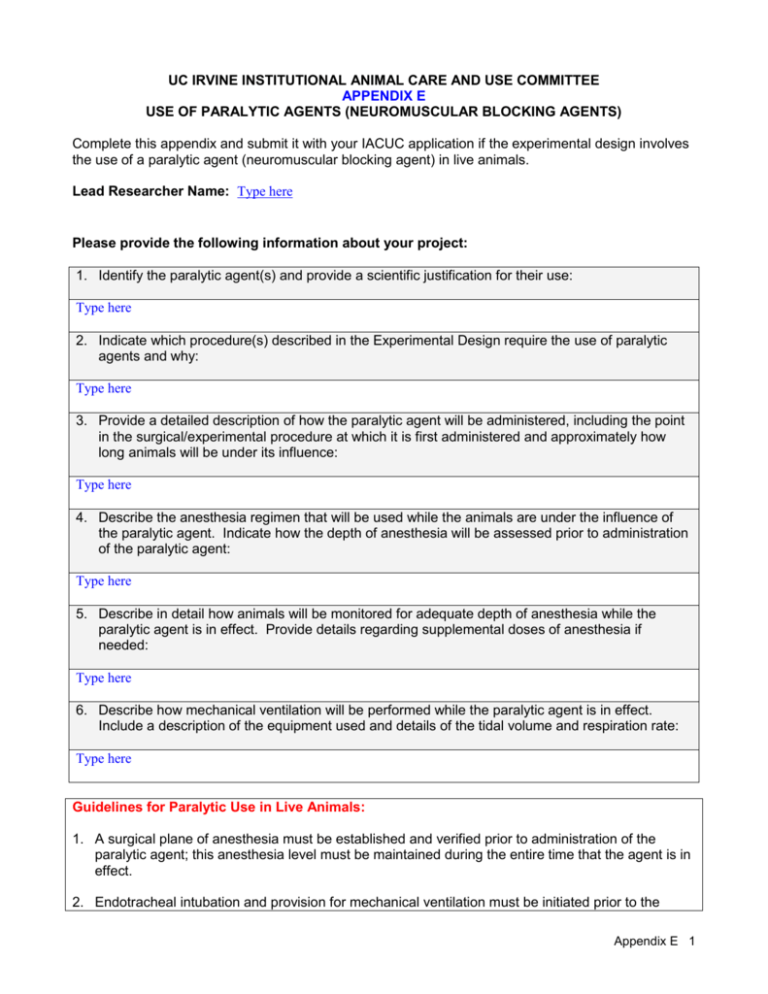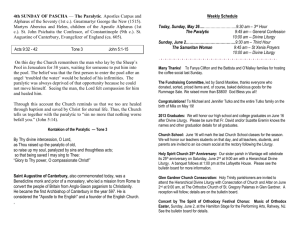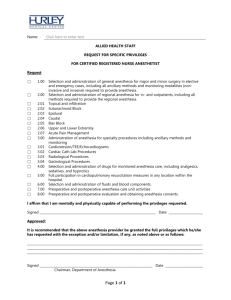Appendix E
advertisement

UC IRVINE INSTITUTIONAL ANIMAL CARE AND USE COMMITTEE APPENDIX E USE OF PARALYTIC AGENTS (NEUROMUSCULAR BLOCKING AGENTS) Complete this appendix and submit it with your IACUC application if the experimental design involves the use of a paralytic agent (neuromuscular blocking agent) in live animals. Lead Researcher Name: Type here Please provide the following information about your project: 1. Identify the paralytic agent(s) and provide a scientific justification for their use: Type here 2. Indicate which procedure(s) described in the Experimental Design require the use of paralytic agents and why: Type here 3. Provide a detailed description of how the paralytic agent will be administered, including the point in the surgical/experimental procedure at which it is first administered and approximately how long animals will be under its influence: Type here 4. Describe the anesthesia regimen that will be used while the animals are under the influence of the paralytic agent. Indicate how the depth of anesthesia will be assessed prior to administration of the paralytic agent: Type here 5. Describe in detail how animals will be monitored for adequate depth of anesthesia while the paralytic agent is in effect. Provide details regarding supplemental doses of anesthesia if needed: Type here 6. Describe how mechanical ventilation will be performed while the paralytic agent is in effect. Include a description of the equipment used and details of the tidal volume and respiration rate: Type here Guidelines for Paralytic Use in Live Animals: 1. A surgical plane of anesthesia must be established and verified prior to administration of the paralytic agent; this anesthesia level must be maintained during the entire time that the agent is in effect. 2. Endotracheal intubation and provision for mechanical ventilation must be initiated prior to the Appendix E 1 administration of the paralytic agent. 3. Use of paralytic/neuromuscular blocking agents should be confined solely to the phase of the procedure for which they are indicated. 4. During the period of paralysis, multiple physiologic indicators of pain and distress (e.g., heart rate, blood pressure) must be monitored at least every 15 minutes as appropriate to the species and recorded in the surgical record. An increase of >20% in any monitored parameter should be considered indicative of a pain/stress response and additional doses of anesthetic must be administered. The use of automated monitoring devices, however, cannot substitute for direct monitoring of the animal by a human observer. A member of the laboratory staff must be present at all times while paralytic agents are in use. 5. The use of end-tidal carbon dioxide monitoring is strongly recommended to ensure adequate ventilation. 6. Core temperature and fluid balance must be maintained within normal levels during the period of paralysis. In the event that animals will be under the influence of the paralytic for long periods of time (e.g., more than 4-6 hours), a urinary catheter must be placed or the urinary bladder must be manually voided. 7. Animals must be spontaneously breathing before anesthesia is discontinued. Research personnel must confirm that animals have fully recovered control of respiration and locomotion at the end of the experiment, before they are returned to their home cages. [ ] By checking this box, the Lead Researcher and all research personnel assure that they have reviewed these guidelines and agree to implement them. References: 1. NRC. (1996) Guide for the Care and Use of Laboratory Animals, Washington, DC: National Academy Press. 2. Appendix D: PHS Policy and Government Principles Regarding the Care and Use of Animals. Animal Welfare Regulations: USDA 9CFR, 2.31 Section D:IV:C; NRC 1992. 3. NRC. (2003). Guidelines for the Care and Use of Mammals in Neuroscience and Behavioral Research. Washington, DC: National Academy Press. 4. NIH (1991) Preparation and Maintenance of Higher Mammal During Neuroscience Experiments: Report of a National Institutes of Health Workshop. Bethesda, MD: NIH/National Eye Institute. 5. Drummond JC, Todd MM, Saidman LJ. (1996) Use of neuromuscular blocking drugs in scientific investigations involving animal subjects: The benefit of the doubt goes to the animal. Anesthesiology. 85: 697-699. 6. Marsch SCU, Studer W. (1999) Guidelines for the use of laboratory animals: what about neuromuscular blocking agents? Cardiovascular Research 42: 565-566. 7. Mason DE and Brown MI. (1997) Monitoring of anesthesia. D.F.Kohn, S.K. Wixson, WJ White, GJ Benson (eds), Anesthesia and Analgesia in Laboratory Animals. San Diego: Academic Press. Appendix E 2






